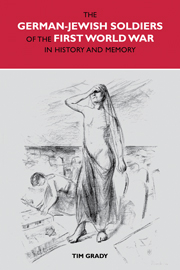Book contents
- Frontmatter
- Contents
- Acknowledgements
- List of Abbreviations
- Introduction
- 1 Dying: War, Mutilation and Mass Death, 1914–18
- 2 Mourning: Defeat, Revolution and Memorialisation, 1918–23
- 3 Commemorating: War Veterans, Ritual and Remembrance, 1923–29
- 4 Forgetting: Nazism, Front Fighters and Destruction, 1929–45
- 5 Discovering: War Victims, War Crimes and Reconstruction, 1945–60
- 6 Embracing: The Growth of Holocaust Awareness and Acknowledgement of the Jewish Soldiers, 1960–80
- Conclusion
- Bibliography
- Index
3 - Commemorating: War Veterans, Ritual and Remembrance, 1923–29
- Frontmatter
- Contents
- Acknowledgements
- List of Abbreviations
- Introduction
- 1 Dying: War, Mutilation and Mass Death, 1914–18
- 2 Mourning: Defeat, Revolution and Memorialisation, 1918–23
- 3 Commemorating: War Veterans, Ritual and Remembrance, 1923–29
- 4 Forgetting: Nazism, Front Fighters and Destruction, 1929–45
- 5 Discovering: War Victims, War Crimes and Reconstruction, 1945–60
- 6 Embracing: The Growth of Holocaust Awareness and Acknowledgement of the Jewish Soldiers, 1960–80
- Conclusion
- Bibliography
- Index
Summary
By the mid-1920s, the much-troubled Weimar Republic was finally beginning to experience some form of domestic stability. The widespread violence that had plagued the revolutionary years was on the wane; industrial production, largely funded by American loans, began to rise, while Berlin was at the centre of a flourishing cultural scene. For many, there were no more potent symbols of these ‘golden years’ than the art, theatre, films and novels of the period, not to mention the innovative work of the Bauhaus design school. However, despite these outward signs of increased stability, all was not well in the new state. Parliamentary election results during this period reveal a very different picture. On each occasion that the country went to the polls in the 1920s the liberal parties, which had mainly been the home of the middle classes, suffered a drop in their share of the vote. Clearly dissatisfied with the current democratic system, this influential section of the electorate began to turn to smaller, often more extreme, special-interest parties instead. More broadly, this splintering of the vote bespoke a failure on the part of republicans to legitimise the new state. Military collapse, an unpopular revolution and social chaos did not offer the Republic's supporters much in the way of founding myths.
Nowhere was the absence of a legitimising national myth more visible than in the Weimar state's attempts to draw out a useable past from the war.
- Type
- Chapter
- Information
- Publisher: Liverpool University PressPrint publication year: 2011



